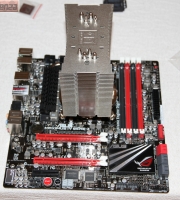
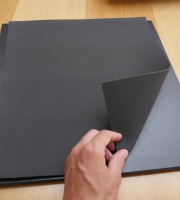
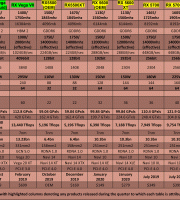
Z87 (May 2013)
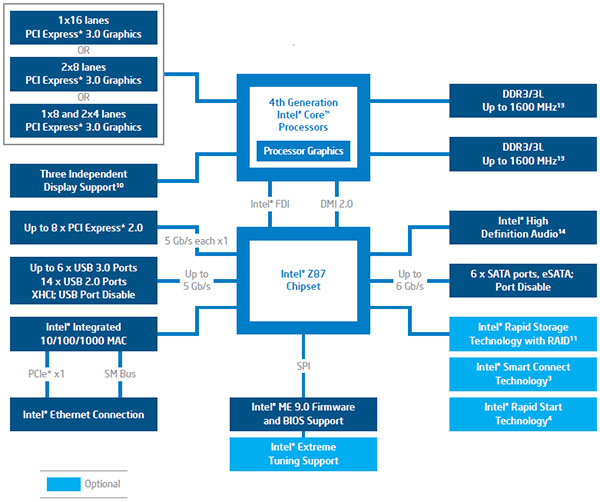
Fast forward another year and our tyrant of transistors is at it again.
The z87 was another chipset aimed at the mainstream user who craved the best possible performance from a decent but ultimately sensible budget. As the z77’s successor, it also proved to be the vessel that carried us into Intel’s fourth generation of “Core” based architecture and gave birth to the the “Haswell” family. These processors occupied a new socket lined with 1150 pins and were twelve in number at launch. Each, like their predecessors contained four cores on a 22nm die with Intel proudly proclaiming performance increases of upto 15% in frequent scenarios. Base speeds ranged upto 3.5ghz and turbo frequencies, a maximum of 3.9ghz. The family consisted of six core i5 chips and six core i7 and in keeping the the “Sandy Bridge” tradition, only the core i7s possessed the ability to hyperthread their way through data.
Other notable features included:
Fresh from production and still emitting the delicate fragrance of lacquer, two more magnificent maternal essentials were eager to serve.
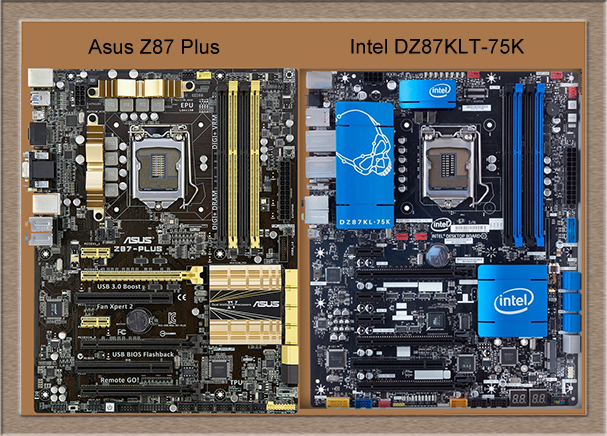
Another Average Joe 1: Ok, Mr Intel, so 12 CPUs this time?
Mr Intel: Not quite, one of them, the Core i7-4770R , is in integrated model I intend for manufacturers to weave directly into their circuitry, you’ll have to wait a while for those, here’s the full menu.
Mr Intel: Remember, it’s K for an unlocked multiplier, S for lower energy consumption, oh yes and I’ve added a third, T, extremely low energy consumption, 20 watts less again to be exact…
Mr Asus: Wait till you see the features of my board. My new software, AISuite three has four way optimization which can over clock your CPU automatically by applying a series of fantastically accurate incremental stress tests. You can configure it for raw performance or maximum economy in just a few clicks. I have an alternative to that board too, well several actually, there’s my Z87-K, Z87-C, Z87-A Z87M-Plus, Z87 Pro, Z87 Expert, Z87-Deluxe, Z87 Deluxe Dual and Z87 Deluxe Quad, some have Wifi and thunderbolt connectors instead of the extra video outputs…and Sata Express ports, have you heard about that, for drives even faster than Sata 3.0, I’ll be offering those too…
Another Average Joe 2: WOOOOOHAAAA, that’s NINE motherboards, all based on the same chipset.
Mr Intel: I guess that’s what happens when you are less strict with your guidelines, no matter!
Mr Asus: No, there’s the Z87-WS too and the Sabretooth Z87, and I have five Republic of Gamers boards in the pipeline, let me tell you….
Another Average Joe 2: No no no no, you can stop right there this z87 plus will do fine just fine and I’ll take a 4770K with it please, can’t wait to clock it to Hades!
Another Average Joe 1: Well, sometimes choices can be too agonizing, I’ll go with your board Mr. Intel, has a few less SATA ports but a couple more PCI Express slots, I have quite a few peripheral cards so those will be useful, and I’ll take a 4770T to boot.
——————————————————————————————————
As 2013 ran its course, our other average joes benefited greatly from their acquisitions as much gaming, video editing, surfing, music making, skyping and plain old fashioned hard work ensued.
The first half of 2014 saw Mr Asus continue to vigorously harvest PCBs and forge board after board while Mr Intel attended to his corporate clients and their insatiable lust for Xeons (let’s not go there…this is really getting tiring). It wasn’t until early summer that our supreme master of the cores (that’s Intel) found himself in dire need of some main stream refreshments…and for our average Joes, this is where the story really starts.